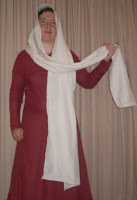Headrails
The simplest veil I know of is the headrail. Firstly it is simple to construct because it is quite simply a long rectangular piece of fabric. In fact a light pashmina scarf makes a great headrail, and requires no construction at all. I find my smallest one that works is 162cm long and a width of 60cm, but a little wider may be good (not too much -try for the distance from the front of your head over your head to your neck and a bit of spare), and any amount of excess length is fine - I have one which is over 2m long.Secondly the headrail is simple because you don't need a fillet under it. This is a good veil for people who are scared of pins in their head, or claim they are too uncoordinated to get a veil on straight, especially at events where no large mirrors are handy. Thirdly the headrail is simple because there are only 2 steps to draping it.
I don't know where the name headrail comes from, but I expect it's a reenactor term. I think the 12th C person would have called it the local equivalent of veil, eg the anglo norman guimple or perhaps coife. I doubt the language would have had a specific word for this type of veil versus that one, but modernly we find it useful, especially when referring to 100's of years of veil types at the same time.
How to drape it
The first step is to place the centre of the veil on top of your head. It may be easier to drape it around your neck like a scarf, then pull it up onto the head.In the picture I've deliberately made the two ends slightly uneven, so it drapes evenly. This really isn't necessary, nobody gets to see both ends at once. Next, grab one end, and toss it over your shoulder. It doesn't matter which side.
And that simply, you have a headrail.
For tasks where the long headrail may drape into things in front of you, simply toss both ends over your shoulders. For even more demanding tasks, tie the ends in a simple single knot behind your back.
Comparison to other veils
While the simplest veil, the headrail isn't quite as versatile as other veils in this manner. I do find myself adjusting it occasionally and it isn't well suited to tasks where I must bend over (it drops off forwards). If I sit in chairs with a back, the headrail also doesn't work as well because it relies on the weight of the fabric to hold the veil tight against my face. Sitting in a chair takes the weight off the veil. For the same reason, while I've seen little evidence for it being the way things were done in most places in the 12th Century, a beaded or heavy trim edging or fringe could really add weight to a headrail, making it stay on better.Extant 12th C images
When I actually look for 12th C headrails, I actually find it difficult to prove such a veil was used. Here are some of the closest images I've found:
Copenhagen Psalter (Kongelige Bibliotek
MS Thott 143 2º:)
England, 1175-1200.
folios 11r, 12v and 15r
These images show an unusual amount of detail for the period - generally you can only see a white or whiteish veil wrapped around a head. But on these examples you can clearly see the veil crosses over itself at the neck. There are a few other examples which do show the crossing of layers of the veil, and many which do not.
But I'm not at all sure what shape of veil is depicted here - we can clearly see a corner on the first image, but that could for example be the corner of a half circle veil as the corner of a rectangular veil. So we must guess based on the shape produced by comparing to our results and hoping that the artist was actually trying for a realistic impression. Whatever shape the veil, both ends are flipped back over the shoulder in all but the first image. And the ends depicted are fairly short - whereas my ends are fairly long to keep this veil closed by itself.
In all but the first image, no hair is visible under the veil - I find this very difficult to achieve with a headrail alone - I generally either need veil pins or an extra layer underneath to cover the forehead, or otherwise my veil creeps backwards on my head.
Overall, I think the headrail is a quick and easy way to introduce people to veils, but I'm not convinced that this is exactly how a veil would be worn. But it does teach about what fabric drapes well, is easy to put people (even if afraid of pins), and teaches them how to flip the ends over their neck - so I think it serves a useful purpose. And it may be right for other time periods.







